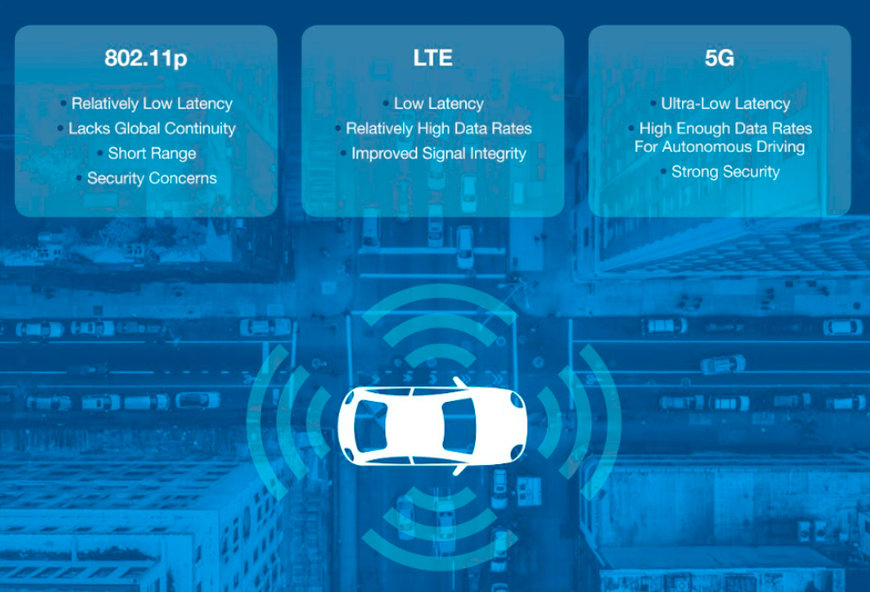V2V and V2I Delivers Time-Critical Data for Autonomous Vehicles
By Mark Patrick, Mouser Electronics.

The communication protocols supporting V2X
What will this blog series cover?
- How self-driving technologies are redefining the automotive landscape
- Overcoming perceptions and embracing self-driving technologies
- Vehicle Autonomy: What are the key stages?
- Sensor Technologies for Autonomous Vehicles
- V2V and V2I delivers time-critical data for autonomous vehicles
- Establishing an Ethical Framework for Autonomous Vehicles
Earlier in this blog series, Blog 3 0 Vehicle Autonomy: What are the key stages?, we highlighted the fact that for full vehicle autonomy to be achieved (SAE Level 5), a self-driving car’s instantaneous knowledge base will depend not only on the vehicle’s own sensors but on receiving information from other vehicles and intelligent road infrastructure in the vicinity. Only when the vehicle’s systems are supplied with a complete and detailed view of its immediate environment can it navigate reliably, safely, and smoothly. These additional sources of information will come from wireless-based vehicle-to-vehicle (V2V) and vehicle-to-infrastructure (V2I) systems.
The underlying wireless protocols used to implement V2V and V2I are still undergoing regional and national technical review and validation, but clearly high-speed synchronous transfer rates with low latency are key requirements, as is data security. The two contenders are a Wi-Fi 5 based dedicated short-range communications (DSRC) protocol (802.11p) and C-V2X that utilises the 5G cellular network. Both protocols work within the 5.9GHz spectrum, but neither supports any form of interoperability.
To date, there has been considerable debate within the industry as to which communication method to adopt, leading some vehicle manufacturers and national regulatory organisations to make their own decision. For semiconductor vendors, where there are long development cycles, some have opted to develop chipsets to support either protocol. Since the 5G network required to support C-V2X deployment is ongoing, it appears that DSRC is in a strong position for the short term. Potentially, waiting for a comprehensive 5G rollout might delay self-driving vehicle trials, hence DSRC’s attractiveness.
DSRC
On first glance, DSRC appears to have the best technical credentials. With a range of up to 300m, high-speed data rates, and a low latency of approximately 5ms, DSRC meets the requirements of V2V and V2I.
It has already been adopted for automotive toll collection systems in Japan, and the Austrian highways agency, ASFINAG, has adopted it for V2V and V2I across their road network. Vehicle manufacturer, VW, has incorporated DSRC connectivity in its new Golf 8 platform. The German city of Ludwigsburg has also selected DSRC to fit their fire and rescue vehicles so they can control and synchronize traffic lights across the city to speed their route to an emergency.
The USA implemented DSRC at an early stage but has since reallocated all its available spectrum to C-V2X. Although DSRC is relatively inexpensive, fears concerning its security and vulnerability to man-in-the-middle attacks and that the cellular-based C-V2X will utilise existing cellular infrastructures mean the debate continues to linger—which is understandable. There is also a concern that DSRC, despite being quoted as offering fast data transfer rates, will be outclassed by 5G’s capabilities once deployments get underway. However, the industry currently appears awash with ‘brinkmanship’ from both camps as to which is best.
C-V2X
The fact that C-V2X can utilise the 5G network infrastructure as it becomes deployed is an obvious advantage. Also, the weight of investment and continued development of cellular networks is a considerable advantage over DSRC, which appears to have no other use cases or future roadmap and will consequently be more expensive to deploy and maintain. 5G has a well-defined strategy of increasing data rates into the tens of Gbps, and exceptionally low latency characteristic and packet prioritisation can be given to V2X data.
The 5G Automotive Association (5GAA) conducted performance analysis between C-V2X and DSRC to simulate congested highway scenarios, where the V2X systems would have to serve large numbers of vehicles. The results highlighted that the 5G network was better equipped than DSRC to accommodate these conditions and still maintain acceptable data rates, latency, and range parameters. Ford went on to extend the scope of the 5GAA’s tests and concluded that C-V2X achieved very acceptable results, particularly in line-of-sight conditions.
In conducting their own review of V2X protocols, the UK government has highlighted several aspects of C-V2X that need further investigation.
- Since the number of use cases for 5G continues to expand, there needs to be more collaboration to maintain security across multiple domains and from end-to-end.
- Likewise, the 5G architecture of multiple layers stipulates a unified framework of security that spans every layer.
- As 5G networks evolve, the security methods put into place now must continue through the life cycle of further architectural changes.
The debate between DSRC and C-V2X is likely to continue for some time, but whatever the outcome, the future of autonomous vehicles relies on access to an ultra-reliable communications network that has high levels of redundancy and wide geographical coverage. For C-V2X, where the focus of 5G deployments is in densely populated areas, self-driving vehicles may initially be limited to urban environments.
www.mouser.com

